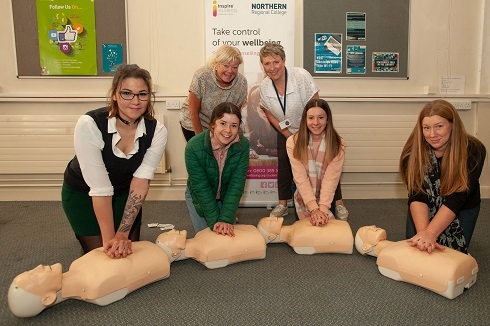CPR (cardiopulmonary resuscitation) is an emergency life-saving technique carried out when someone stops breathing or their heart has stopped beating.
Each year, around 1,500 people in Northern Ireland suffer an out-of-hospital cardiac arrest (OHCA) where resuscitation is attempted but sadly only 1 in 10 survives.
Kyle Leckey, Health and Safety Co-ordinator at Northern Regional College, said bystander CPR and early defibrillation can increase survival rates of OHCA significantly, so it is important that people know what to do in an emergency situation.
He explained that the low rates of bystander CPR are due to fear. Some people are afraid they may face legal action or make the sufferer’s case worse.
Kyle said: “These awareness sessions are to help to break down the myths around CPR and using an AED. Over 80% of OHCA happen in a residential location so it is highly likely that it could be someone you know that may need your help.
“The College is committed to playing its part to help save lives by increasing awareness of the importance of bystander CPR and early defibrillation.
“People need to know what to do in an emergency situation because if CPR is given, the chance of survival is increased by two to three times. Defibrillation within three to five minutes of a person collapsing can increase survival rates by as much as 50 – 70 %,” he said.
The Health and Safety Co-ordinator said he was delighted with the success of the initiative which saw over 500 staff and students attend the College’s CPR zones where trained staff explained the chain of survival to highlight the importance of CPR and early defibrillation.
Kyle continued: “We want to strengthen the chain of survival by raising awareness of CPR and give staff and students the confidence and practical experience so they can help in the event of an emergency OHCA.”
“The chain of survival includes four key inter-related steps: early access, dial 999 immediately; early CPR; early defibrillation; and early advanced care (transfer to hospital).
“If these steps are delivered effectively and in sequence, survival rates from an OHCA are optimised but a chain is only as strong as its weakest link. This is why it is so important for as many people as possible to know what to do should they ever find themselves in an emergency situation.”


